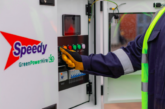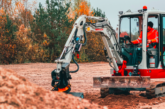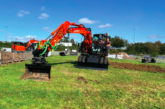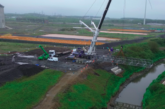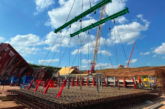
HS2 and its industry partners have achieved certification by the Energy Saving Trust for the second stage of a retrofit innovation trial, meaning the green technology can now be rolled out to larger Non-Road Mobile Machinery (NRMM) and bring substantial benefits for the whole industry.
The solution, manufactured by British company Eminox, adds exhaust technology to existing engine systems on plant machinery and upgrades them to the latest EU Stage V engine class, leading to reduced emissions on construction sites. It allows HS2 construction sites to reduce particulate and NOx emissions and embodied carbon, while also bringing significant direct capital savings through the reduction of plant scrappage and the need to purchase high volumes of new large specialist plant.
This trial for large engines in NRMM took place on a Balfour Beatty 403kW Bauer BG30 Rotary Rig. Emission testing and data analysis was conducted by Emissions Analytics and Imperial College London (Centre for Low Emission Construction). It showed a reduction in emissions that meet the latest engine air quality standards, resulting in better air quality for the workforce and local communities.
It follows on from the first trial last year for medium engines, carried out on a 179kw Balfour Beatty Stage IIIA piling rig (Junttan PM20) which was also certified by the Energy Saving Trust – an industry first. Following this successful trial, HS2 Ltd has been working with the Manufacturing Technology Centre to support the adoption of retrofit solutions for existing plant and machinery across the project’s main works civils contractors. This latest retrofit certification means all medium and larger engine equipment bandings can be adapted, including plant with longer life spans.
HS2’s Head of Innovation Howard Mitchell said: “As our work ramps up to reduce HS2’s carbon footprint, our innovation programme is providing fantastic opportunities to work with the supply chain, British manufacturers and academics to test the very latest green technology on our construction sites.
“We have set stringent requirements for air emission requirements for all construction vehicles and Non-Road Mobile Machinery (NRMM), to reduce emissions and improve local air quality around construction sites. We’re delighted that the certification for retrofit on large NRMM means the whole industry, as well as HS2, will benefit from this innovation.”
Eminox’s Director of Retrofit & Aftermarket, Carlos Vicente said: “We would like to thank HS2, Balfour Beatty and Imperial College for their support in this collaboration. Retrofit has enabled on road equipment to meet the latest clean air objectives in our cities and now though the support we have received, we can also bring the benefits of sustainable and economical solutions that provide the industry with access to stage V equivalent compliance for a fraction of the price of new equipment.”
Daniel Marsh, Centre for Low Emission Construction, Imperial College London said: “HS2 has set the most stringent machine emission standards for any major infrastructure project in western Europe to protect health and the environment. The second trial using retrofit technology, tested on piling rigs, has allowed us to successfully demonstrate the emission reduction potential of the Eminox SCR system, leading to its certification with the EST NRMM scheme for use across larger engine groups.
“This will not only help to significantly reduce the air pollution impacts across the HS2 project as these new measures are adopted by other tier 1 contractors, but also leave a legacy for the whole UK construction sector as these cleaner machines are deployed elsewhere in support of other projects.”
Bekir Andrews, Associate Director, Group Sustainability, Balfour Beatty Plc said: “Environment and Communities alongside Materials are key components of Balfour Beatty’s “Building New Futures” sustainability strategy. The Non-Road Mobile Machinery retrofit solution gives us the opportunity to extend the asset life of some of our larger machinery, to reach the highest emission standards.
“We see this kind of a technology as a key means to improving air quality for local communities and also doing our bit to protect the environment. We look forward to continuing this momentum and reaping the rewards as we apply this innovative solution on other specialist plant we own.”

